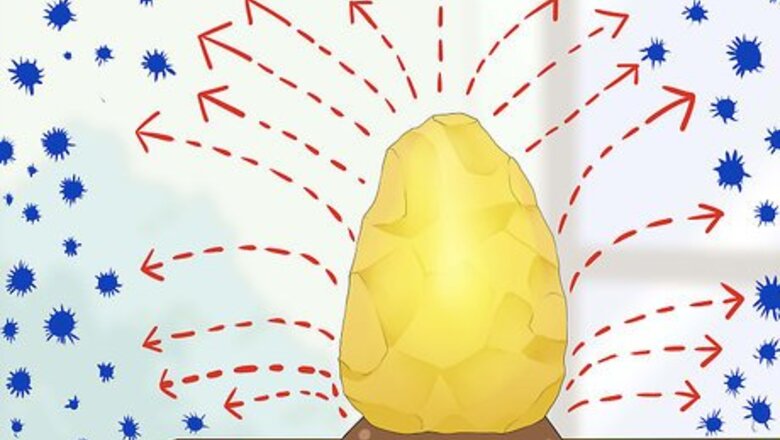
views
X
Research source
Using a Himalayan Salt Lamp to Improve Your Health
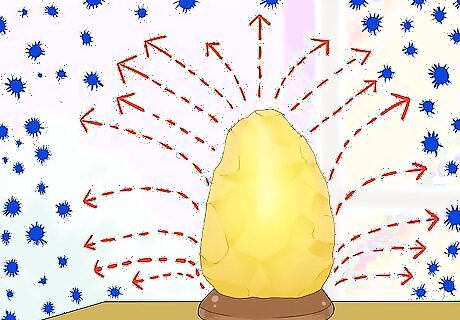
Remove contaminants from the air. You may be wondering how a chunk of salt with a light bulb in it can clean and deodorize the air. The answer lies in a process, called hygroscopy. Himalayan salt attracts water molecules in the air and absorbs them. These water molecules carry tiny particles of dust, pollen, and smoke with them, which are deposited on the surface of the salt lamp. As the internal bulb heats the salt, the absorbed water evaporates back into the air, but the contaminants they previously carried remain stuck in the salt. You can even fight allergy and asthma symptoms with salt lamps. Aside from dust and other everyday particles in the air, your Himalayan salt lamp will also remove pet dander, mold, and mildew from the air.

Exchange harmful positive ions with helpful negative ions. Many of the molecules floating around you home are positively charged. Positive ions have been associated with detrimental health effects, including a diminished ability to filter the air you breathe. However, hygroscopy - the process by which Himalayan salt cycles water molecules - not only cleans the molecules, it also changes their charge. During the absorption of water molecules from the air, Himalayan salt also removes any extra positive ions and converts them to negative ions. These negative ions are then released independently, and may help your body filter the air you’re breathing. Note, however, that the negative ions released by salt lamps are different from those used in medical practices to help oxygenate blood. The most common sources of positive ions in contemporary homes are electronics. Accordingly, keep a salt lamp in any room that you store and use a lot of electronics - especially if you tend to leave them on.

Improve your mental health. Salt lamps can also help you relax, and may help you maintain a positive mood. In fact, the potential for improved respiratory function and blood flow associated with negative ions may help more oxygen get to your brain. In turn, you may experience mental boosts, such as improved concentration and positive emotions. Negative ions in the air may even lead to higher amounts of serotonin in your brain, which contribute to feelings of happiness. Use lamps to help fight seasonal affective disorder, as the ambient light offered by salt lamps can emulate sunlight.

Do not assume salt lamps will cure any medical ailments. Claims about the health benefits of salt lamps should taken with a grain of... well, salt. For instance, halotherapy - which involves the inhalation of pulverized salt crystals and emulates breathing the air in a salt cave - is commonly said to help decrease breathlessness associate with pulmonary diseases. However, these claims are essentially unproven by medical research. In short, do not rely on salt lamps to treat a medical condition. Always seek and strongly consider the advice of a medical professional for persistent health maladies.
Positioning Himalayan Salt Lamps

Keep salt lamps in each room you spend a lot of time in. Aside from providing clean, easy-to-breathe air, salt lamps can also help you feel energized throughout the day. In order to receive these benefits, however, you’ll likely need multiple salt lamps. Have you ever felt refreshed during a visit to the beach, standing next to a waterfall, or simply in the shower? Each of these expose you to negative ions that are effectively the same as those generated by Himalayan salt lamps. The shift won’t be immediate, but you’ll likely feel more energized about a week after installing lamps in the rooms where you spend a lot of your day.
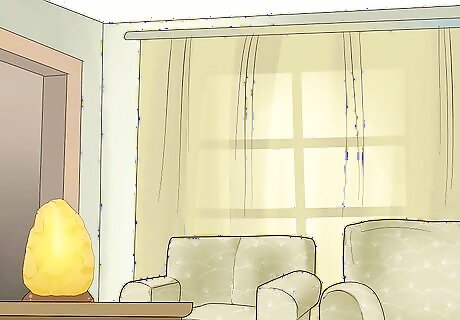
Place a salt lamp in your living room. Especially if you store electronics in your living room, it’s worth featuring salt lamps as well. Since large electronics in particular emit plenty of positive ions, it can be beneficial to place salt lamps right next to computers or televisions. If you work in an environment that will allow it, place a salt lamp near your work computer as well.
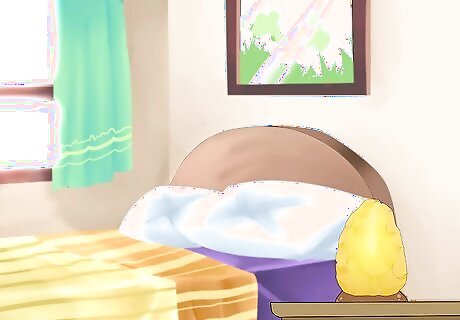
Keep a salt lamp in your bedroom. One of the most advantageous locations to place a salt lamp is your bedroom. This is in part because concentrations of positive ions can diminish your quality of sleep. The negative ions dispersed by your salt lamp, however, can help remove these positive ions and encourage oxygen supply to your brain. If the light emitted by the candle keeps you up, consider placing the lamp outside of your line of sight. You can also leave the candle on during the day to filter the air, and turn it off during the night.

See particular advantages in the winter. The air in your home is probably especially dirty and positively charged during the winter months. This is largely because closed windows means air is circulating much less than it does when it’s warm out. Not only can salt lamps be especially useful in cleaning indoor winter air, they can also help prevent you from getting sick from the cold and flu viruses that are also more common during the chillier months.
Selecting and Maintaining Your Lamps
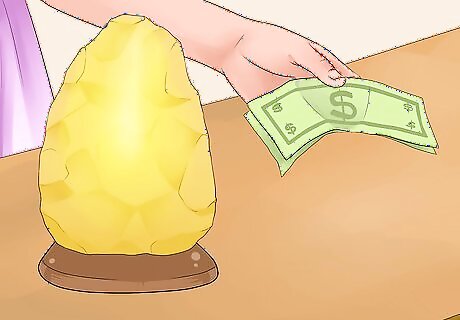
Purchase high quality Himalayan salt lamps. You will receive the greatest benefits from a lamp that is made of pure, food grade Himalayan salt. The light fixture itself should also be solid and made of high quality components. This will help prevent potential electrical risks involved with salt and liquid deposits within the lamp. There are a lot of fake, cheap “salt” lamps for sale. Check the country of origin. The salt itself should have originated in Pakistan, though assembly elsewhere can be okay. Note that a real Himalayan salt lamp will provide dim, uneven light, will be rather fragile, and will feel damp to the touch sometimes.

Get a big enough salt lamp. For an average bedroom, a roughly 5 lb (2.3 kg) salt lamp is sufficient. In a living room-type space, go for a larger lamp. Twelve pound (5.4kg) lamps are perfect for these spaces. As a rule of thumb, choose a lamp with one pound of salt crystal per sixteen square feet of floor space. If a room has high ceilings, choose a lamp with extra weight. Note that multiples lamps will be equally effective as a large lamp. For instance, two six-pound lamps (2.7 kg each) can offer the same benefits as a twelve pound (5.4kg) lamp.
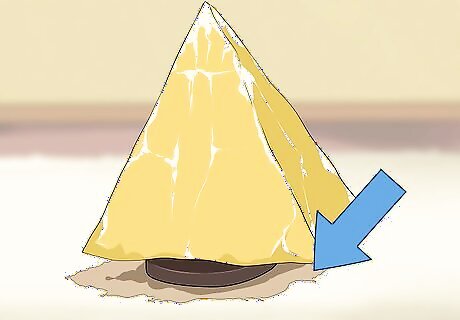
Watch out for copious sweating. One issue you may have to deal with is excessive sweating from your lamp. While a hot lamp will cause most of the moisture the salt absorbs to evaporate, the lamp may sweat water in especially damp climate. To prevent a sweating lamp from damaging the surface on which it sits, place a wooden coaster or ceramic dish beneath the lamp. Your lamp will also likely sweat when you turn it off, as there is no heat to promote evaporation. If you do not wish to leave the lamp on 24 hours a day, definitely place a coaster or something else to catch water underneath your lamp. Be sure to empty and replace anything you leave beneath a lamp that has collected water before turning the lamp back on. Consider using a higher-wattage bulb in your lamp to promote more evaporation. Check the fixture's specifications for the maximum wattage, which will likely be located on the bulb’s receptacle.
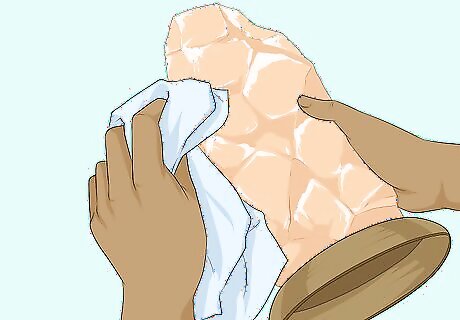
Clean your lamp and check for build up. Your lamp will need to be cleaned from time to time, especially if it’s successfully pulling lots of dust and other particles from the air. Turn off the lamp and allow it to cool down, then wipe the lamp with a moist lint-free cloth or sponge. More importantly, ensure that liquid and salt have not built up within the lamp, as this can lead to dangerous electrical discharges. You will likely notice debris wiping off of the surface of the salt crystal. Once the crystal appears clean, turn it back on to evaporate any remaining moisture. You can also use a dry, lint-free cloth to dry the crystal whenever you notice it is sweating. Doing this will also help clean the salt and prevent liquid accumulation beneath the lamp.
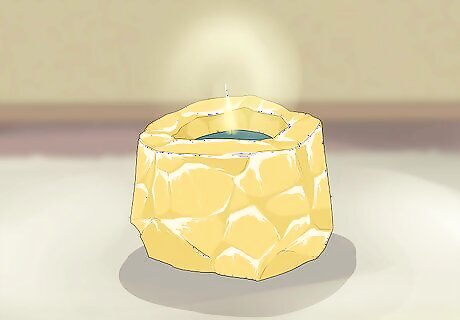
Use a Himalayan salt candle holder. As an alternative to electric salt lamps, you can also get blocks of Himalayan salt sculpted to hold tea candles. These are cheaper, just as visually appealing, and as effective as electronic options - though they are often smaller. For an especially relaxing (and refreshing) effect, place multiple salt crystal candle holders around your bathroom or bedroom.


















Comments
0 comment